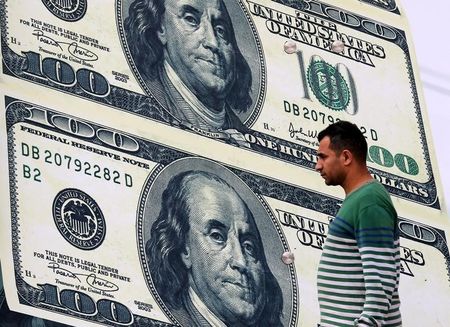Forex
Dollar slips after Biden pulls out, euro rebounds after losses

Investing.com – The U.S. dollar slipped lower Monday following U.S. President Joe Biden’s decision to end his re-election campaign, with the euro benefiting despite its weak tone after last week’s European Central Bank meeting.
At 06:00 ET (10:00 GMT), the Dollar Index, which tracks the greenback against a basket of six other currencies, traded 0.2% lower to 103.942, flipping after posting its first weekly gain in three last week.
Dollar retreats amid political uncertainty
The dollar has retreated following the weekend’s news that President Biden will no longer seek reelection, endorsing Vice President Kamala Harris as his potential replacement.
“Investors will now switch their attention to how Kamala Harris fares against Donald Trump in the opinion polls – assuming she is appointed the presidential candidate at the Democratic National Convention on 19-22 August,” said analysts at ING, in a note.
The dollar had received a boost as the likelihood of a Trump presidency grew following Biden’s disastrous debate performance last month and questions about his age and health.
The main economic data release this week will arrive on Friday, with June’s personal consumption expenditures index set to test market expectations that the Federal Reserve is all but certain to cut interest rates in September.
Economists are expecting the to have climbed 0.1% for the second straight month, which would bring three-month annualized core inflation down to the slowest pace this year, below the Fed’s 2% target.
Euro bounces in wake of ECB decision
rose 0.2% to 1.0893, bouncing after weakness in the wake of the keeping rates steady at its meeting last week.
Analysts flagged that the ECB offered no concerted push back at last week’s policy meeting on the heavy pricing for a cut in September, which remains a strong base case.
“This week’s eurozone business sentiment readings, due Wednesday and Thursday, will help shape the narrative that policy is too restrictive and could prompt a little downside for the euro,” said ING.
Markets are pricing in almost two ECB rate cuts for the rest of the year.
traded 0.1% higher at 1.2931, after topping 1.30 for the first time in a year last week in the wake of the decisive election victory for the Labour Party, ending 14 years of sometimes chaotic Conservative rule.
“Some are no doubt making the case that this is a removal of the Brexit risk premium in sterling, aided by new Prime Minister Keir Starmer’s desire to engage more closely with Europe,” said ING.
“While we have some sympathy with that view, we ascribe sterling strength more to sticky UK inflation and the limited pricing of BoE rate cuts this year, plus July’s drop in the dollar on the back of softer US price data.”
Yuan slips after PBOC rate cut
In Asia, rose 0.1% to 7.2727, close to levels last seen in November.
Weakness in the yuan came after the People’s Bank of China unexpectedly cut its benchmark to further loosen monetary policy and support the economy.
The cut comes as China struggles with a slowing economic recovery- concerns over which have added to mounting pressure on the yuan.
Recent weakness in the yuan also came amid concerns over a Trump presidency, given that Trump has maintained a negative rhetoric towards Beijing.
fell 0.5% to 156.63, with the yen continuing to see wild swings amid speculation that the Japanese government has intervened in currency markets.

 Forex3 years ago
Forex3 years agoForex Today: the dollar is gaining strength amid gloomy sentiment at the start of the Fed’s week

 Forex3 years ago
Forex3 years agoUnbiased review of Pocket Option broker

 Forex3 years ago
Forex3 years agoDollar to pound sterling exchange rate today: Pound plummeted to its lowest since 1985

 Forex3 years ago
Forex3 years agoHow is the Australian dollar doing today?

 Cryptocurrency3 years ago
Cryptocurrency3 years agoWhat happened in the crypto market – current events today

 World3 years ago
World3 years agoWhy are modern video games an art form?

 Commodities3 years ago
Commodities3 years agoCopper continues to fall in price on expectations of lower demand in China

 Economy3 years ago
Economy3 years agoCrude oil tankers double in price due to EU anti-Russian sanctions


























